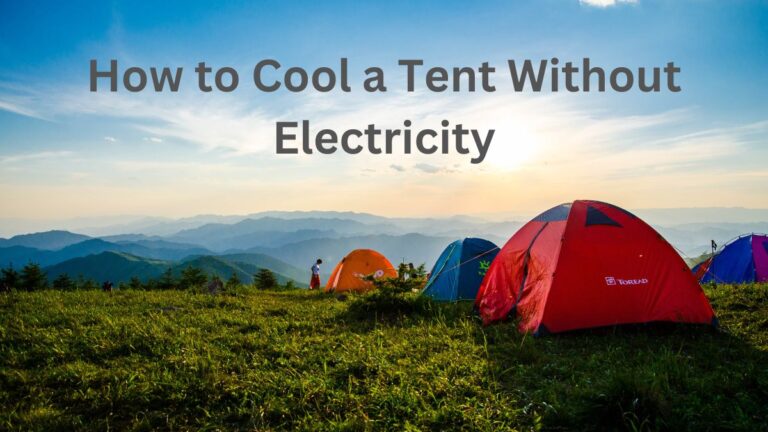When camping during hot summer days, it’s essential to find ways to stay cool inside your tent. This article will guide you through various non-electric cooling techniques, ensuring a comfortable camping experience even without access to electricity.
Choosing the Right Location
To cool your tent naturally, consider the following:
Find Shade and Natural Airflow:
Look for a campsite with ample shade from trees or natural structures.
Position your tent in a way that allows natural breezes to flow through.
Avoid Direct Sunlight:
Select a campsite where the tent won’t be exposed to direct sunlight for extended periods.
Pitch your tent under a tree or use a camping canopy for shade.
Ventilation and Airflow
Create Cross Ventilation:
Open windows or mesh panels on opposite sides of the tent to allow cross ventilation.
Place a fan or portable battery-operated fan near one of the openings to enhance airflow.
Utilize Mesh Windows and Doors:
If your tent has mesh windows and doors, keep them open to allow fresh air circulation.
Use mosquito nets to keep insects out while promoting ventilation.
Insulation and Reflective Materials
Use Reflective Tarps or Emergency Blankets:
Place reflective tarps or emergency blankets on the tent’s roof to deflect sunlight.
This helps reduce the amount of heat absorbed by the tent.
Insulate the Tent Floor and Walls:
Place foam pads or insulating materials beneath your tent to prevent heat transfer from the ground.
Hang insulating blankets or foam boards on the inner walls of the tent to minimize heat absorption.
Evaporative Cooling Techniques
Wet a Towel or Bandana:
Dip a towel or bandana in water and place it around your neck or on your head.
The evaporating water will provide a cooling effect on your body.
Hang a Wet Sheet or Blanket:
Hang a wet sheet or blanket over the tent’s entrance or windows.
As the air passes through the damp fabric, it will cool down before entering the tent.
Strategic Tent Setup
Properly Orient the Tent:
Set up your tent in a way that minimizes exposure to the sun during the hottest parts of the day.
Consider the movement of the sun and adjust the tent’s positioning accordingly.
Utilize Tent Awnings or Flysheets:
Attach a rainfly or tarp to your tent, leaving space for air circulation.
This creates a shaded area around the tent, reducing the temperature inside.
Campsite Planning
Time Your Activities:
Plan outdoor activities for the cooler parts of the day, such as early morning or evening.
Rest and relax during the hottest hours to avoid unnecessary heat exposure.
Use Natural Shade and Water Bodies:
Take advantage of natural shade provided by trees, cliffs, or large rocks.
Camp near water bodies like rivers or lakes, as the breeze near water can provide a cooling effect.
Nighttime Cooling
Choose a Cooler Sleeping Bag:
Opt for sleeping bags designed for warmer temperatures.
Look for sleeping bags with ventilation options to enhance airflow.
Cool the Tent Before Sleeping:
Spray water on the tent’s exterior to cool it down.
Open all windows and doors to let fresh air circulate before entering the tent.
Alternative Cooling Devices
Battery-Powered Fans:
Bring a portable battery-powered fan to improve air circulation inside the tent.
Place the fan strategically to direct airflow where it’s needed the most.
Portable Evaporative Coolers:
Consider using a portable evaporative cooler specifically designed for camping.
These devices use water to create a cooling effect, providing relief in hot environments.
Conclusion
By implementing these non-electric cooling techniques, you can ensure a more enjoyable camping experience even in the absence of electricity. Stay cool, relax, and make the most of your time in nature.
FAQs.
What are some effective ways to cool a tent without electricity?
This question asks for various methods that can be used to cool a tent without relying on electricity. The answer could include suggestions such as using natural ventilation, shading the tent, or employing evaporative cooling techniques.
Are there any natural methods to keep a tent cool during hot weather?
This query focuses on natural approaches to maintaining a cool temperature inside a tent when faced with hot weather conditions. Answers may include strategies like choosing a shady campsite, using reflective tarps or blankets to block sunlight, or positioning the tent in a way that maximizes airflow.
How can I lower the temperature inside a tent without using electrical appliances?
This question seeks alternatives to electrical appliances for reducing the temperature inside a tent. Possible responses might involve utilizing insulation materials, employing passive cooling techniques like cross-ventilation, or using cooling accessories specifically designed for camping.
Are there any specific materials or fabrics that can help in cooling a tent?
This query explores the possibility of utilizing specific materials or fabrics to aid in cooling a tent. Responses could include suggestions like using lightweight and breathable fabrics, selecting tents with good ventilation features, or considering shade cloths or reflective materials to reduce heat absorption.
What are some tips for maximizing airflow inside a tent to keep it cool?
Here, the focus is on enhancing airflow within a tent to promote cooler conditions. Answers may include advice such as keeping tent doors and windows open, using mesh panels or windows for ventilation, or strategically positioning the tent to catch natural breezes.
Can using shade or setting up a tent under trees help in cooling it down?
This question explores whether seeking shade or positioning a tent under trees can contribute to cooling it down. The answer might include explanations of how shade can help reduce direct sunlight and lower the temperature inside the tent, although other factors like humidity should also be considered.

